44.4 VERTEBRATE DIVERSITY
In many ways, the last stop on our tour of animal diversity is the most familiar because it includes our own species, Homo sapiens. The animals known as vertebrates are named for their jointed skeleton that runs along the main axis of the body, forming a series of hard segments collectively termed vertebrae (singular, vertebra). In addition to features shared with other chordates, vertebrate animals are distinguished by a cranium that protects a well-developed brain, a pair of eyes, a distinctive mouth for food capture and ingestion, and an internal skeleton commonly mineralized by calcium phosphate (Fig. 44.28). The vertebrates also have a coelom in which the organs are suspended, and a closed circulatory system. Like the other chordates, vertebrates have pharyngeal slits in at least the early embryonic stages.

Many of the features that separate vertebrates from invertebrate chordates can be found in the head, including a bony cranium that protects the brain, joined in most vertebrates by the mandible (or jawbone) to form a skull. This protective helmet for the delicate neuronal tissues permits the development of a larger brain than would otherwise be possible. The mandible permits eating foods such as other living animals, themselves often protected by hard shells, and plants containing hard lignin. Because the bottom scavenger hagfish have a cranium but not vertebrae (or a mandible), some biologists use the name “Craniata” for this group, rather than the traditional “Vertebrata.”
44-22
44.4.1 Fish are the earliest-branching and most diverse vertebrate animals.
We sometimes think of fish as one group, but the aquatic animals we commonly call “fish” include four distinct groups of aquatic vertebrates, not all of them monophyletic (Fig. 44.29).
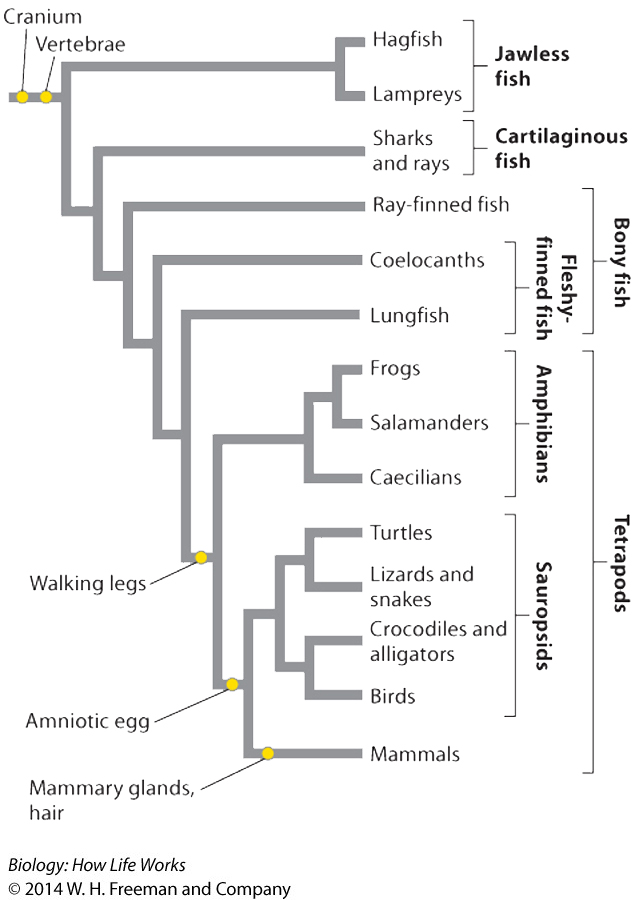
The earliest branching craniates are the hagfish and lampreys (Fig. 44.30). These animals have a cranium built of cartilage but lack jaws. Lampreys also have a vertebral column built of cartilage. Hagfish lack vertebrae, though current research suggests that this trait existed in a common ancestor of hagfish and lampreys, but was lost in hagfish. These eel-like organisms feed on soft foods without the aid of jaws because they diverged before jaws evolved from pharyngeal slits. Hagfish feed on marine worms and on dead and dying sea animals, while lampreys live parasitically, sucking body fluids from fish prey. Both hagfish and lampreys have a series of gill slits through which water enters to bring oxygen to the gills.
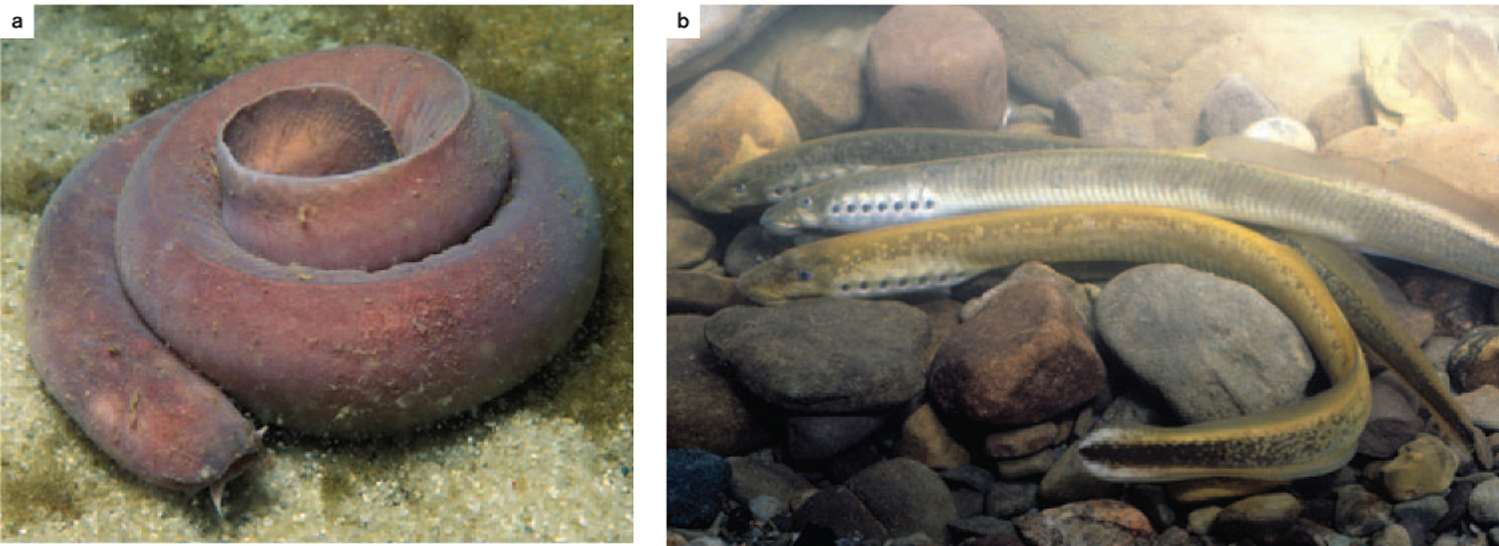
Biologists have long debated the phylogenetic relationships among hagfish, lampreys, and other vertebrate animals. The presence of a vertebral column in lampreys convinces many biologists that lampreys are the sister group to other vertebrates and hagfish the sister group to all vertebrates, including lampreys. The debate continues, but several lines of molecular data now favor the view shown in Fig. 44.29, that hagfish and lampreys together form the sister group to all other vertebrates. About 65 species of lampreys and hagfish live in freshwater and coastal oceans. Fossils record the existence of many extinct species of jawless fishes. When we include fossils, the jawless fishes as a whole are paraphyletic because one of their groups gave rise to fish with jaws.
44-23
Chondrichthyes, or cartilaginous fish, form the next deepest branch on the vertebrate tree. This monophyletic group includes about 800 species of sharks, rays, and chimaeras, all of which have jaws and a skeleton made of cartilage (Fig. 44.31). These fish deposit calcium phosphate minerals only in their teeth and in small toothlike structures called denticles embedded in the skin. The best-known cartilaginous fish are the sharks, many of which are predators that put those mineralized teeth to good use. On the other hand, the group also includes whale sharks, filter-feeding animals that, at a length up to 40 feet (12 m), are the gentle giants of the sea. Rays are closely related to sharks but have a flattened body adapted for life on the seafloor, where they feed on clams and crabs. The cartilaginous fish can retain levels of urea in their tissues that would poison other vertebrates, a physiological adaptation that helps them to maintain their salt balance without well-developed kidneys (Chapter 41). Nearly all Chondrichthyes occur in the oceans, but Bull Sharks (Carcharhinus leucas) commonly swim into rivers—they’ve been recorded well up the Mississippi—and there are several freshwater species of rays.
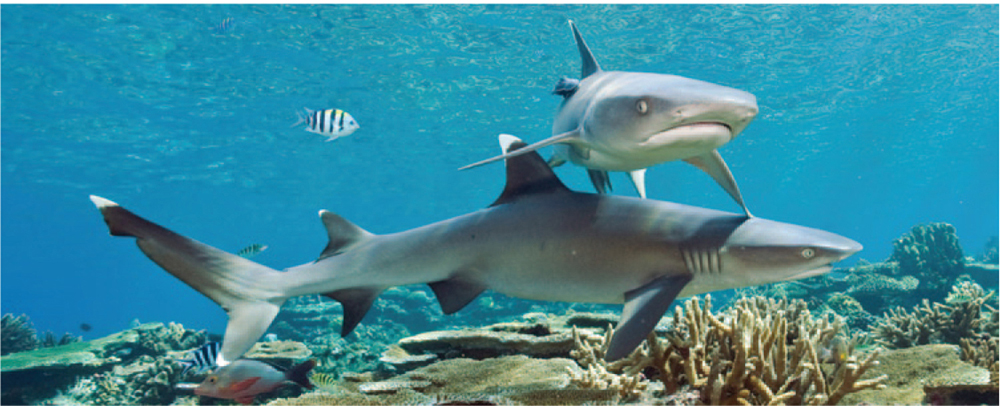
Moving up one more branch in the vertebrate tree, we encounter the Osteichthyes, or bony fish (see Fig. 44.29). Bony fish have a cranium, jaws, and bones mineralized by calcium phosphate. Numbering about 20,000–25,000 fresh and seawater species, these are the fish that we most commonly encounter (Fig. 44.32). Bony fish are by far the most diverse group of vertebrates, possessing several unique features that facilitate their occupation of diverse niches. First, they have a system of movable elements in their jaws that allows them to specialize and diversify their feeding on many different types of food. Second, they possess a unique gas-filled sac called a swim bladder that permits exquisite control over their position in the water column through changes in buoyancy. Third, bony fish have kidneys that allow them to regulate water balance and so occupy waters over a wide range of salinity.
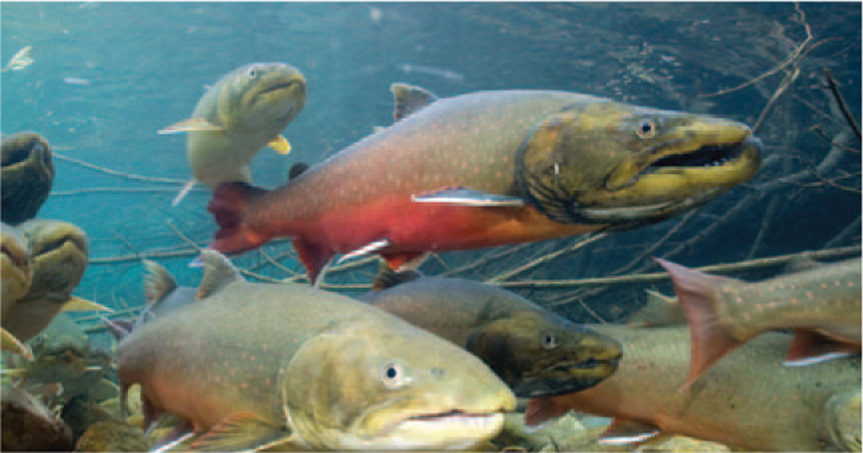
44-24
The swim bladder plays a special role in vertebrate evolution. Early vertebrates evolved a gut sac that enabled them to gulp air to obtain additional oxygen. In some fish, this sac evolved into the swim bladder, but in one group the sac was modified to become a lung. Charles Darwin was among the first to recognize that the swim bladder and the vertebrate lung are homologous organs.
44.4.2 The common ancestor of tetrapods had four limbs.
Most animal phyla occur in the oceans, and many are exclusively marine. A subset of animal phyla has successfully colonized freshwater, and a smaller subset has radiated onto the land. Eleven groups on the animal phylogenetic tree contain both aquatic and terrestrial species: nematodes, flatworms, annelids (earthworms and leeches), snails, tardigrades (microscopic animals with eight legs, sometimes called water bears), onychophorans (velvet worms), four groups of arthropods (millipedes and centipedes, scorpions and spiders, land crabs, and insects), and vertebrates. In each of these groups, the aquatic species occupy the earliest branches, and the terrestrial species occupy later branches. No two of these groups share a last common ancestor that lived on land; thus, they all made the transition independently. Earlier, we outlined the extraordinary diversity of terrestrial arthropods. Here, we focus on vertebrates as the other great animal colonists of the land.

Most bony fish have fins that are supported by a raylike array of thin bones. About a dozen closely related species, however, have paired pectoral and pelvic fins. These fish are called fleshy-finned fish and include the coelacanth and lungfish (Fig. 44.33). Although these animals resemble other fish, the coelacanth and lungfish are the nearest relatives of tetrapods, four-legged animals. Lungfish can survive periods when their watery habitat dries by burying themselves in moist mud and breathing air. Coelacanths first appeared over 400 million years ago and were thought to have been extinct for over 80 million years until a specimen was discovered in a fish market in South Africa in 1938. Hence, they are sometimes referred to as living fossils. There are two living species of coelacanths and three species of lungfish, one each in South America, Africa, and Australia. Because the fleshy-finned fish are the closest relatives of tetrapods, there is no monophyletic group that corresponds to our popular notion of “fish.” To be monophyletic, such a group must include the tetrapods.
44-25
Fossils document the anatomical transition in vertebrate animals as they moved from water to land, including changes in the form of the limbs, rib cage, and skull (see Fig. 23.20). Living tetrapods include amphibians, such as frogs and salamanders; lizards, turtles, crocodilians, and birds; and mammals. The last common ancestor of all these animals had four limbs, hence the name Tetrapoda (“four legs”). Some, however, like snakes and a few amphibians and lizards, have lost their legs in the course of evolution.
There are over 4500 species of Amphibia (“double life”), ranging in size from tiny frogs a few millimeters in length to the Chinese Giant Salamander, which is over 1 m long. Their name reflects their distinctive life cycle (Fig. 44.34). Most species have an aquatic larval form with gills that permit breathing under water and an adult form that is terrestrial and usually has lungs for breathing air. Amphibians must reproduce in the water, and so are not completely terrestrial. Whereas many amphibian larvae graze on algae, the adults are predators and often have a muscular tongue for capturing prey. Many are protected by toxins they secrete from glands in their skin, sometimes advertised by their brilliant color patterns. Most amphibian adults require moist skin for breathing and consequently have small lungs, with toads and red efts being notable exceptions.
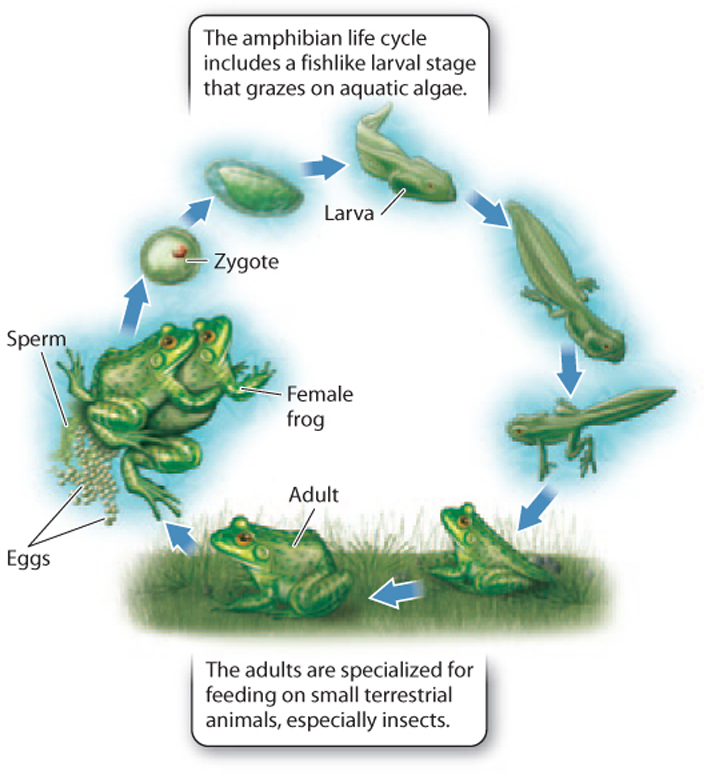
44.4.3 Amniotes evolved terrestrial eggs.
Like insects, some vertebrates evolved an egg adapted to tolerate dry conditions that accompany life on land. The amniotic egg has a desiccation-resistant shell and four membranes that permit gas exchange and management of waste products produced by the embryo (see Fig. 42.10). These eggs must be fertilized internally before the eggshell is produced by the female because sperm cannot penetrate the shell. Amniotic eggs permit long development times, with the embryo’s nutrition supported by a large yolk or the placenta. They keep wastes separated from the embryo so they do not poison it, giving the embryo time to build more complex bodies than otherwise would be possible.
The amniotic egg can exchange gases while retaining water, and so permits the group of vertebrates known as amniotes to live in dry terrestrial habitats that amphibian eggs cannot tolerate. Amniotes include lizards, snakes, turtles, and crocodilians (about 6000 species of scaly animals commonly referred to as “reptiles”), as well as the birds and mammals (Fig. 44.35). Most mammals, many lizards, and some snakes have evolved live birth rather than laying eggs. Nonetheless, they retain the specialized membranes characteristic of all amniotes. Instead of being wrapped around the embryo inside a tough egg shell, these membranes surround and protect the embryo inside the womb.
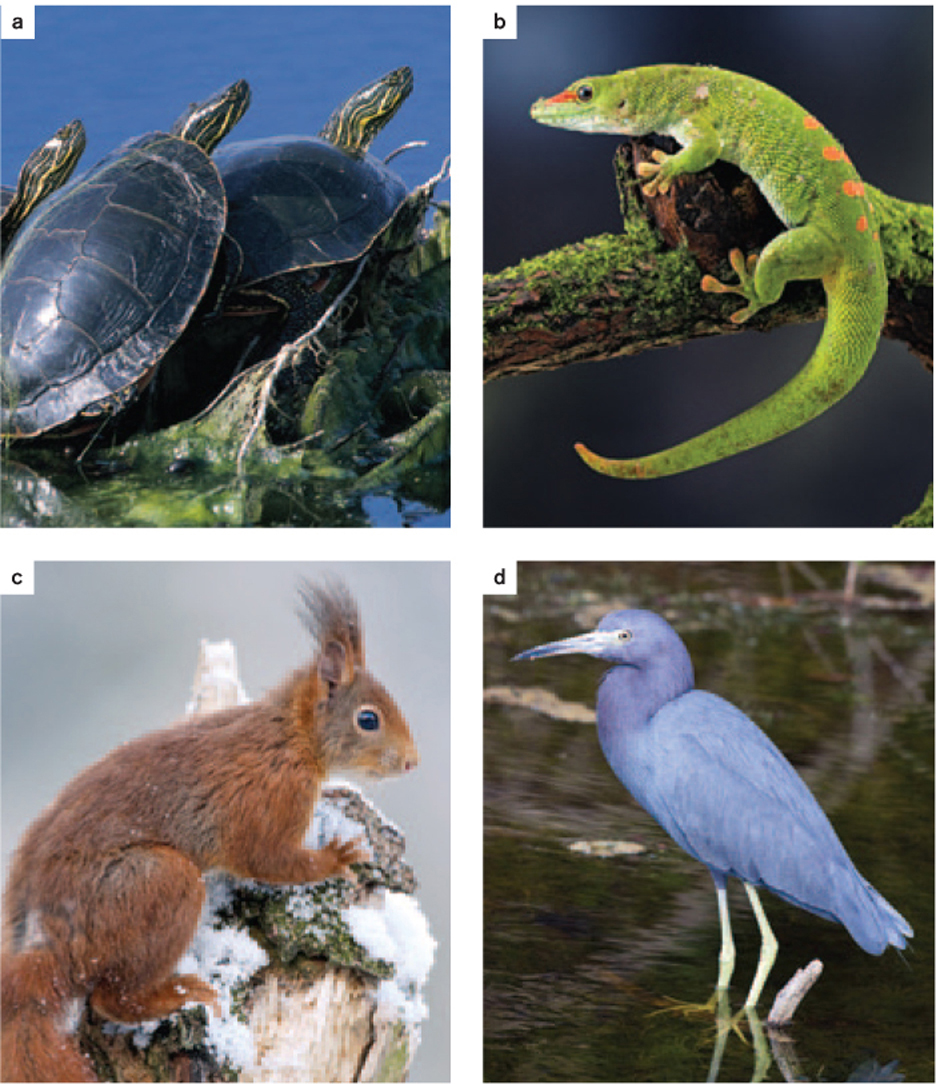
44-26
As shown in Fig. 44.29, amniotes form a monophyletic group with two major branches. One is made up of mammals, and the other contains turtles, birds, and the amniotes traditionally grouped together as reptiles. Like fish, however, reptiles are not monophyletic—birds are descended from reptiles, although you have to look closely to see the similarities between the two groups. Birds lack teeth, most of their scales have been modified into feathers (except on the legs and toes), and they are generally adapted for flight. Adaptations for flight include hollow bones that are light but remain strong, and a method of breathing that extracts much oxygen from each breath, permitting their high-performance flight (Chapter 39).
One consequence of this streamlined, lightweight body is a lack of the heavy jaws needed for grinding plant leaves or other low-nutrition foods. Instead, birds have their grinding organ, the gizzard (also found in other reptiles), inside their bodies near their center of gravity, where it interferes less with flight. Only one kind of bird, the weak-flying Amazonian Hoatzin, can actually feed on leaves. As discussed in Chapter 23, fossils show that birds diverged from dinosaur ancestors, and molecular sequence comparisons indicate that crocodiles are the closest living relatives of birds.
Question Quick Check 5
ZB/eW1sjqdgCK4GA7QsY+yDVLRkeq4+CGSWOn+R0qj3Wet+QZC7qNA09V2+r3mSPjRDjCU94Nq6I3JJA3DMlE/P7zPCwkPXuAll mammals are covered with hair and feed their young milk from the mammary glands for which the class Mammalia is named. Like many other groups of animals and plants, the early-branching mammals show intermediate stages in the evolution of the body plans that dominate on Earth today. The first fossils that clearly show hair appeared about 200 million years ago, during the Triassic Period. Like feathers in birds, hair permits retention of body heat. The earliest-branching living mammals, the monotremes, lay eggs, like birds or lizards (Fig. 44.36), but their hatched young drink milk secreted from pores in the skin of the mother’s belly. Among these are the Australian platypus and the echidna, or spiny anteater.
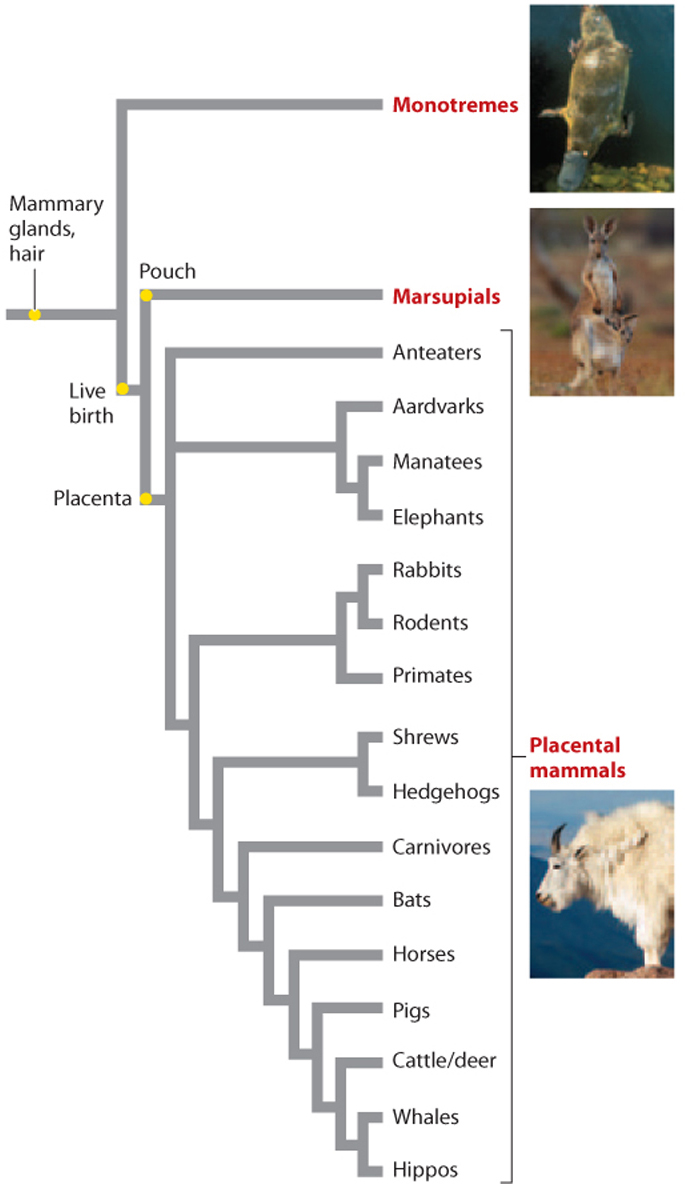
The first mammals that gave birth to live young appeared in the Jurassic Period, about 125 million years ago. These animals gave rise to the two major groups of living mammals, marsupial and placental mammals. Marsupials include kangaroos, koalas, and related groups native to Australia, as well as the opossums found in the Americas. Their young are born at an early stage of development, and the tiny babies must crawl to a pouch where mammary glands equipped with nipples provide them with milk. Only later do fully formed juveniles emerge from the pouch and begin life on the ground.
The placental mammals are named for a temporary organ called the placenta that develops in the uterus along with the embryo, providing nutrition that enables the offspring to be larger and more quickly independent when born (Chapter 42). Most living mammals fall into this group. Placental mammals include the carnivores, such as lions and weasels; the primates, including monkeys, apes, and humans; and the hooved mammals, which include cattle, pigs, deer, and—perhaps surprisingly—their marine off-shoot, the whales.
44-27
All together, the familiar mammals mentioned so far number about 1000 species. The most diverse mammals, however, belong to two groups of mostly small animals, the bats and the rodents. Bats, which evolved flight and a form of sonar called echolocation to find food at night, include more than 1000 species. The largely plant-feeding rodents are as diverse as the large mammals and bats combined, numbering more than 2000 species. Beavers, gophers, rats, mice, hamsters, and squirrels are all rodents. Their evolutionary success is often attributed to innovations in tooth development. Their teeth are unusual in growing continually throughout life. This constant growth permits constant wear, and so allows these animals to gnaw through hard protective coverings to obtain nutrition from a remarkably wide variety of otherwise hard-to-access sources like the insides of seeds.